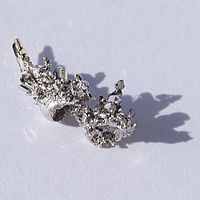
Photo from wikipedia
Electrocatalytic production of H2O2 via a two-electron oxygen reduction reaction (ORR-2e-) is regarded as a highly promising decentralized and environmentally friendly mechanism for the production of this important chemical commodity.… Click to show full abstract
Electrocatalytic production of H2O2 via a two-electron oxygen reduction reaction (ORR-2e-) is regarded as a highly promising decentralized and environmentally friendly mechanism for the production of this important chemical commodity. However, the underlying challenges related to the development of catalytic materials that contain zero or low content of noble metals and that are relatively more active, selective, and resistant for long-term use have become a huge obstacle for the electroproduction of H2O2 on commercial and industrial scales. The present study reports the synthesis and characterization of low metal-loaded (≤6.4 wt %) catalysts and their efficiency in H2O2 electroproduction. The catalysts were constructed using gold palladium molybdenum oxide (AuPdMoOx) and palladium molybdenum oxide (PdMoOx) nanoparticles supported on graphene nanoribbons. Based on the application of a rotating ring-disk electrode, we conducted a thorough comparative analysis of the electrocatalytic performance of the catalysts in the ORR under acidic and alkaline media. The proposed catalysts exhibited high catalytic activity (ca. 0.08 mA gnoble metal-1 in an acidic medium and ca. 6.6 mA gnoble metal-1 in an alkaline medium), good selectivity (over 80%), and improved long-term stability toward ORR-2e-. The results obtained showed that the enhanced ORR activity presented by the catalysts, which occurred preferentially via the two-electron pathway, was promoted by a combination of factors including geometry, Pd content, interparticle distance, and site-blocking effects, while the electrochemical stability of the catalysts may have been enhanced by the presence of MoOx.
Journal Title: ACS applied materials & interfaces
Year Published: 2022
Link to full text (if available)
Share on Social Media: Sign Up to like & get
recommendations!